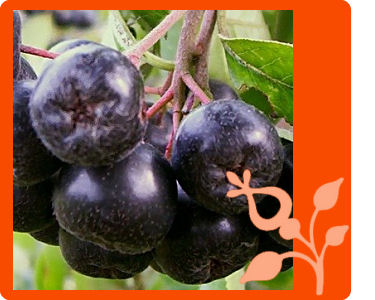aronia
|
|
Aronia / Black ChokeberryAronia (Aronia melanocarpa Mich.) |
Aronia also known as black chokeberry is a cold-hardy shrub, showing white flowers in the spring and colorful red foliage and heavy, dark blue almost black fruit in the fall. Aronia fruit is virtually inedible due to its extreme astringency. Though aronia is native to eastern North America, it has been planted extensively in Europe and Asia. In Russia, Finland, Denmark and eastern Europe the fruit is widely used for juice and fruit-wine production. Edible aronia, with large-fruit crops, first started to grow Russian scientist I. V. Michurin. As a result of numerous experiments, he received a new plant with a large edible fruit. The most of today's cultivated aronia plants are selected from the Russian cultivars.
Aronia berries in their natural form feature very thin whitish waxy coat on them, as you see in other berries bilberries, blueberries, etc. This berry-wax makes a protective layer protecting from drying out but also from excessive moisture.
Human food
Aronia fruit is virtually inedible due to its extreme astringency. It
derives the name “chokeberry” from the astringency (dry, puckering mouth feel) caused by phenolics found in the fruits. Marja PK
et al. (2) reports that aronia contains 40.1 mg/g of total phenolics far more than bilberry ( 29,7mg/g).
Aronia berries can be canned whole or the juice extracted for jelly making, as well as healthful fruit drinks. In Russia a kind of home-made aronia vine called "nalivka" is traditionally made.
More than bilberries and the popular blueberries, aronia berries are the richest fruit source of anthocyanins and other antioxidants.
Medical uses
Aronia juice is said to be good for diabetes, urinary tract infections, cardiovascular ailments and influenza (flu).
There are indications that anthocyanins as antioxidants have health promoting effects in general, which include reduced risk of coronary heart disease, improved night vision. However, many of these claims are not proven scientifically. Anthocyanins are important antioxidants, but their effect on human health is still poorly understood. These antioxidants can prevent free radicals from damaging components in the cells and causing oxidative stress.
In the prophylactic and therapeutic purposes aronia-berries are not only used fresh, frozen and dried fruits, but also processed products with the best taste: jam, marmalade, jelly, candied fruit, juice, wine.
Aronia berry contains oxalic acid, a naturally occurring substance found in some fruits and vegetables, which may crystallize as oxalate stones in the urinary tract in some people.
Cosmetic and Beauty Products Industry
The berry juice contains high levels of anthocyanins used as source of red colour in cosmetics. Swedish producer of natural cosmetics Ecouna AB launched Aronia Berry Hair Cure that contains berry antioxidants and protective berry-wax extracted from aronia berries.
Industrial use
Aronia berries can be canned whole or the juice extracted for jelly making, as well as healthful fruit drinks. The juice contains high levels of anthocyanins (the source of red color) and flavonoids. The strong, stable natural color is used in the food industry as food additive with E number E163.
Sources
- Wikipedia
-
KÄHKÖNEN, Marja P., et al. Antioxidant activity of plant extracts containing phenolic compounds. Journal of agricultural and food chemistry, 1999, 47.10: 3954-3962.
- Picture
- USDA
- Anthocyanin
- Arctic Naturals Aronia Berry Hair Cure
